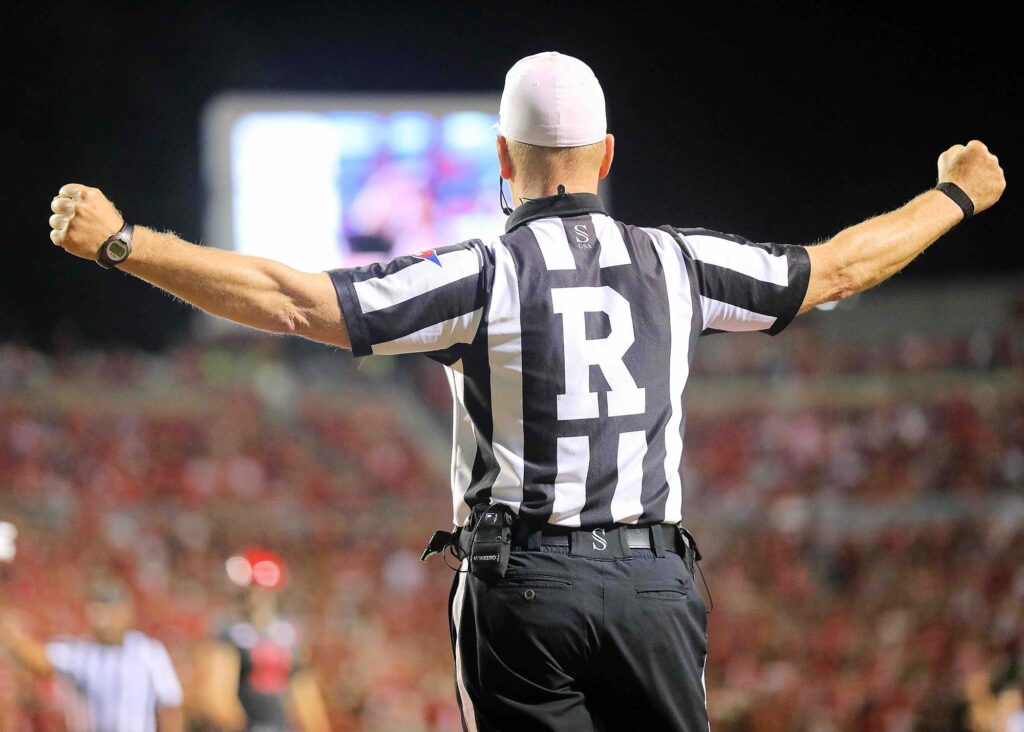
It’s college football season!
But wait… you read this blog for its PR, marketing, storytelling and business tips — not for sports commentary.
Hang tight. I’ll tie this to an important business principle in a moment.
The Pack
Growing up in the Milwaukee suburbs in the ’60s and ’70s, I distinctly remember my Papà always watching the Green Bay Packers on TV. Those iconic green and yellow uniforms are ingrained in my memory. In fact, I’m pretty sure they were green and yellow even on our old black-and-white TV.
Back then, I didn’t know there was any other football worth watching — college football wasn’t even on my radar. Who were the Wisconsin Badgers? To me, they were just a team I occasionally saw in red and white uniforms on the pages of the Milwaukee Journal sports section. But I never paid much attention.
That all changed when I enrolled at Brigham Young University (BYU) in 1983. Some guy named Steve Young (you may have heard of him) was the quarterback in his senior season. The first college football game I ever watched was the BYU Cougars playing the Baylor Bears, and even though BYU lost in a close 40-36 game, I was hooked. BYU won the rest of their games and finished the season 11-1.
I’ve been a college football fan ever since. In fact, I enjoy it even more than the NFL.
Divisive, Noninclusive College Football Terms
Now fast-forward 40+ years. College football has grown into a financial behemoth with insane TV contracts and unbelievable Name, Image and Likeness (NIL) deals for players. In the process, those who’ve been able to secure more revenue are called Power 4 (P4) teams and those who have not secured as much revenue are now called Group of 5 (G5) teams.
Now I don’t have a problem rewarding success. That’s capitalism/the free market at work. But if all these schools are Division I (D-1) schools, part of the Football Bowl Subdivision (FBS), then why is one saddled with a belittling name? Here’s a great 2021 Sports Illustrated article that addresses this topic.
I’ve never liked the P4 (formerly P5 until the PAC-12 conference blew up when 10 teams fled to other conferences) and G5 monikers. I especially disliked it when BYU was labeled a G5 team — until they joined the Big 12 last year.
To be clear — it’s not that some schools make more money than others that I have an issue with — it’s this labeling that irks me. Some businesses make more, a lot more, than others, like Amazon, Apple and Microsoft. There are small, medium and large businesses.
Is that any different for college football? I say it is. Here’s why…
A small business has the potential to scale and become a big business. However, it’s impossible for a G5 school to become a P4 school unless they’re invited. The G5s aren’t given the same treatment.
The second thing that irks me is P4 schools appear to be using their financial position to justify the usage of the belittling G5 label. The P4’s deep financial resources allows them to build better facilities, entice more of the top recruits, and hire the best coaches. It’s as if P4 schools are using this wealth disparity as a tool to hamper the growth and success of G5 schools — even though they’re all part of the same college football division.
I’m sure the labeling continues in a P4’s pitch to 5-star recruits: “We have P4 facilities. They only have G5 facilities. You’re a P4-quality recruit. This should be a no-brainer for you.”
Look at the results when these so-called power conference schools play G5 schools. According to research posted by a fan on Reddit, these conferences’ winning percentage from 2014-2020 is anywhere from 74-88%.
The Eye-Popping P4 Financial Perks
Just for fun, let’s take a quick peek at P4 conference TV contracts and P4 players’ NIL deals:
- Big Ten Conference (2022): $7 billion over seven years. Each Big Ten school receives around $62 million annually.
- Southeastern Conference (2020): $3 billion over 10 years.
- Big 12 Conference (2023): $2.28 billion over six years.
- Bryce Young (Alabama, QB): NIL deals worth over $1 million.
- Quinn Ewers (Ohio State, QB): $1.4 million NIL deal.
- Caleb Williams (USC, QB): Estimated $2.4 million in NIL deals.
These jaw-dropping figures reflect the staggering wealth concentrated within the 4 conferences. But that’s no justification for the treatment.
The Belt-Tightening G5 Financial Breadcrumbs
G5 schools, by contrast, operate on a fraction of this budget, with far fewer resources to support their programs and athletes. The wealth disparity between these two groups is glaring and continues to widen), creating a divisive landscape in college athletics.
Here are a couple of examples of G5 conference TV contracts:
- American Athletic Conference: Signed a 12-year, $1 billion deal with ESPN in 2019, averaging approximately $83.3 million per year. When broken down per school, each AAC member receives about $7 million annually.
- Conference USA: Signed a five-year deal with CBS Sports Network and ESPN in 2016, worth around $2.8 million annually per school.
These figures are significantly lower compared to the multibillion-dollar deals secured by the P4 conferences. For example, the Big Ten’s payout per school is nearly nine times higher than what AAC schools receive.
Now check out a few G5 players’ NIL deals:
- Grayson McCall (Coastal Carolina, QB): Estimated to have earned about $400,000 in NIL deals.
- Bailey Zappe (Western Kentucky, QB): Secured around $100,000 in NIL deals during his record-setting 2021 season.
In contrast, top P4 players like Alabama’s Bryce Young and USC’s Caleb Williams have NIL deals worth over $1 million. This highlights how P4 players often command deals that are sometimes 10 times higher than those of their G5 counterparts.
The numbers tell a clear story: P4 conferences and their athletes are operating in a completely different financial stratosphere compared to G5 schools. This stark contrast is reflective of the widening gap between the haves and have-nots in college football. But that doesn’t justify the P4 and G5 categorizing.
Kudos to the P4 schools for their financial success. All I’m saying is don’t use it to put all the other teams in a G5-branded box that’s virtually impossible to escape from.
Words sway public perception. Either call all teams in the top college football division D-1 or FBS teams, or create another college football division. I’d hate to see the latter happen, but I think that’s where we’re headed.
Translating This Into the Workplace
Now, what’s all this have to do with business?
Well, what if we labeled job candidates or employees as “P4” and “G5” based on their perceived value or status, using their race, gender, or financial status as a determining factor? Imagine a situation where “P4” employees are given all the top-tier positions, the most resources, massive bonuses, and prime opportunities, while “G5” employees are left “scrambling” for whatever is left.
Would this be fair? Absolutely not. It would create a toxic work environment, demoralize employees, and undermine the principles of fairness and respect.
Just as the disparity in college football has created a divide, similar treatment in the workplace could lead to significant issues in morale and productivity.
Using position and wealth to lift oneself above others to disparage others is wrong. Period.
EVERYONE Should Be Treated Equally
As leaders and professionals, it’s essential to treat everyone with equal respect and dignity. We should love all, regardless of race, religion, gender, age, etc. Imagine if we treated others as we would like to be treated?
By fostering an inclusive and fair work culture, we not only uplift our employees but also enhance the overall success and harmony of our organizations. And we create a playing field where every employee is valued.
This is the only way to ensure that every team member has the opportunity to thrive.
When the top executives receive parking privileges, obscene bonuses and other perks, it’s as if they’re P4 employees and the rest of the staff are G5ers. If this is a company’s corporate culture, then chances are they have a high percentage of employee disengagement and a high employee turnover.
What do your employees think of your corporate culture?
The 3 Big Takeaways
- Check to see if there are disparities within your organization.
- Foster a merit-based culture where everyone has equal opportunities to succeed.
- Treat all employees with the respect and dignity they deserve, regardless of their position.
Want to discuss your hiring process? Your corporate culture? Or your favorite college football team? Schedule your appointment with us here.
And one more thing: GOOOOOOOOOOO COUGARS!

Jeffery E. Pizzino, APR is a spin-free public relations pro who is passionate about telling the why of your story with clarity, impact and authenticity. He began his PR career in 1987 at Ketchum Public Relations in New York City but has spent the majority of his career as a solopreneur. He’s AuthenticityPR’s Chief Authentic Officer and also functions as the fractional CCO for technology startup Converus.
Jeff has an MBA in Management from Western International University and a Bachelor of Arts degree in Communications — with an emphasis in PR — from Brigham Young University. He’s a native of Milwaukee, Wisconsin, but also holds an Italian citizenship. Jeff and his storyteller wife Leticia have four children and four grandchildren. In his extremely limited nonwork hours, he studies italiano, practices guitar, gardens, disc golfs, reads, listens to New Wave music, serves in his church, watches BYU football, and plays Dominion and Seven Wonders. Email Jeff.

